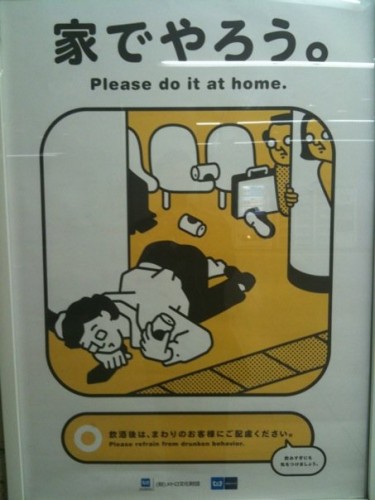
Reuters has a list of Japanese commuters’ common pet peeves:
1. Noisy conversation, horsing around
2. Music from headphones
3. The way passengers sit
4. Cellphone ringtones and talking on phones
5. Manners when getting on and off trains
6. Applying make-up
7. Littering
8. Sitting on the floor of the train
9. Riding the train drunk
10. Riding a crowded train with a child stroller
Most Mutant Frog readers will probably not find anything new on the list. Even the train companies are aware of them – most are covered in Tokyo Metro’s awesome “Please do it at Home” poster series (above, and read the Sandra Japandra blog if you want to laugh your ass off). Some seem more reasonable than others – can a mother really avoid bringing her kid on the train?
Pet peeves about daily life are simply a part of the human condition – American motorists all get pissed off at people who don’t use their blinkers, and on and on. However, in Japan these complaints seem to take on an extra sense of urgency because commuting on a packed train (often for more than an hour each way) is often so intimate and potentially dangerous. The pressure on your chest as that last person piles on. The feeling of being shoved as people stampede out at a major transfer station. The anxiety women must feel that the hand behind them could start getting too familiar.
With trains as crowded as Tokyo’s, everyone has an interest in maintaining some semblance of order and control. That’s maybe the one thing that keeps people in a tightly packed train from suffering a breakdown (and allows people to concentrate on a newspaper or Nintendo DS).
To deal with this, I think the people of Tokyo (and possibly all Japanese cities) have come up with one unwritten, overarching meta-rule that unites them all – do not stand out. People who stand out violate this order and thus subject themselves to the furtive glance of doom, that momentary registering of disapproval.
Even those who violate a few of the pet peeves themselves will feel annoyed at others who do the same. That’s because this rule is enforced by a million individual pet peeves manifesting themselves passive-aggressively. For example, I sometimes eat chocolate on the train but hate it when someone eats a sandwich or something I can smell. In my head, I feel like my eating is cleaner and therefore less rude.
This might be a stretch, but as a foreigner I feel like I automatically violate the rule just by being different. Once people see a white man they can never be sure if I’ll follow all the rules. Hence, just about every time I enter a reasonably packed train car I am greeted with half a dozen glances. I don’t necessarily think it’s racist–for most people it’s based on experience and it’s no more hostile than the automatic glances that would be directed toward other potential scofflaws – construction workers, thuggishly dressed kids, gyaru, etc etc.
Day in and day out, I share the train with the people who glare at me, and I start to glare back. I get territorial about my comfort zone – the handrail in front of the bench seats gives you enough room to read – and resent anyone who would violate it. I start to understand why people go out of their way to avoid talking to strangers. And I definitely get why people don’t bother giving up their seats to old people and pregnant ladies. Those people are breaking the rule!
This is why I think alleviating the insanely crowded train situation is vital to improving the national mood. I ridiculed Roger Cohen for talking about the gloomy attitude in Japan, but on that point he was right. People look like hateful, unhappy zombies during their commutes. The train companies are doing their best, but I feel like the media and politicians avoid really focusing on it because it’s one of those tough, intractable problems with no good solution. Better to let the plebes focus on how awful it is that some celebrities use drugs. But why not try some bolder solutions, like a second, identical Yamanote line, or double-decker train cars?
As a man with a short commute, I should be the last to complain about this. But I can’t help but thinking about it. It’s a national obsession, and in almost three years of living here it’s become mine as well.


